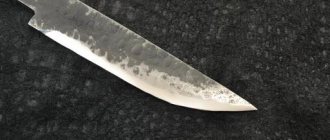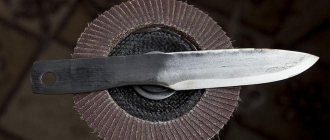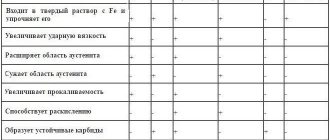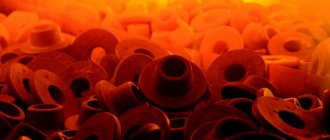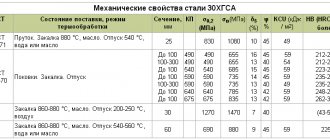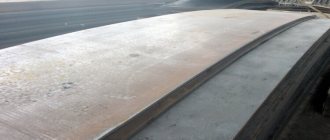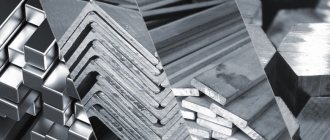Application of steel grade X12M?
Die steel is used for the manufacture of the following primary metal products: circles, squares, sheets, strips, pipes. Standard circles made of X12M steel are considered to have a diameter of 1.2 to .5 cm or more. The X12M square is produced in sizes from 3.0 to 19.0 cm. Depending on the length, there are dimensional, multiple dimensional and unmeasured, as well as the material for its manufacture. X12M sheets are quite thick, which guarantees their strength and the ability to be used for the production of matrices used with operating pressures up to 1600 mPa. The thickness of X12M sheets ranges from 4 to 8 cm.
The material used for the production of a universal high-quality product is X12M strip. It is made in the form of a solid metal profile and is widely used in industry, as well as in construction. Its advantages include corrosion resistance, reliability and versatility. They can have dimensions of 1.6x3.5 cm; 8x20 cm and are made in large sizes. X12M steel pipes, produced in any size, are widely used. A distinctive feature of the product is its significant wall thickness, which allows it to be used in the metalworking, engineering and even aviation industries. The greatest demand is for circles and stripes X12M, which you can buy from us at low prices in St. Petersburg and Moscow.
Order Circle st X12M wholesale or retail in the shortest possible time with delivery throughout Russia. You can view the availability and prices of an item in our catalog or by calling our manager at the specified phone number.
see stock and prices >>
Chemical composition in % of material X12M
| C | Si | Mn | S | P | Cr | Mo | V |
| 1.45 — 1.65 | 0.15 — 0.35 | 0.15 — 0.4 | up to 0.03 | up to 0.03 | 11 — 12.5 | 0.4 — 0.6 | 0.15 — 0.3 |
Temperature of critical points of the X12M material.
| Ac1 = 830, Ac3(Acm) = 855, Ar1 = 750, Mn = 230 |
| Hardness of X12M material after annealing, | HB 10 -1 = 255 MPa |
Physical properties of the X12M material.
| T | E 10- 5 | a 10 6 | l | r | C | R 10 9 |
| hail | MPa | 1/Grad | W/(m deg) | kg/m3 | J/(kg deg) | Ohm m |
| 20 | 7700 | 580 | ||||
| 100 | 10.9 |
Remaining metal steel X12M for December-January 2021-2022.
| Name | brand | size | remainder | price |
| Circle | X12M | 100mm | 0,206 | 310000 |
| Circle | X12M | 110mm | 0,438 | 310000 |
| Circle | X12M | 112mm | 0,37 | 310000 |
| Circle | X12M | 115mm | 0,203 | 310000 |
| Circle | X12M | 120mm | 0,382 | 310000 |
| Circle | X12M | 12mm | 0,385 | 310000 |
| Circle | X12M | 130mm | 0,21 | 310000 |
| Band | X12M | 14×25mm | 0,283 | 330000 |
| Circle | X12M | 150mm | 0,209 | 310000 |
| Circle | X12M | 153mm | 1,05 | 310000 |
| Circle | X12M | 155mm | 0,213 | 310000 |
| Band | X12M | 15×26mm | 0,824 | 330000 |
| Circle | X12M | 16mm | 1,14 | 310000 |
| Circle | X12M | 180mm | 0,274 | 310000 |
| Circle | X12M | 18mm | 0,5 | 310000 |
| Band | X12M | 20×60mm | 0,216 | 330000 |
| Circle | X12M | 230mm | 0,63 | 310000 |
| Circle | X12M | 235mm | 0,298 | 310000 |
| Circle | X12M | 3310mm | 1 | 310000 |
| Circle | X12M | 35mm | 0,205 | 310000 |
| Circle | X12M | 45mm | 0,692 | 310000 |
| Circle | X12M | 50mm | 0,254 | 310000 |
| Sheet | X12M | 50mm | 3,785 | 310000 |
| Band | X12M | 70×200mm | 0,32 | 330000 |
| Circle | X12M | 70mm | 0,773 | 310000 |
| Circle | X12M | 79mm | 0,249 | 310000 |
| Square | X12M | 80mm | 0,841 | 350000 |
Composition and transcript
The standards for marking Kh12F1 steel are the same as for any other alloys produced by the metallurgical industry. The letter “X” at the beginning of the mark indicates chromium alloying. The numbers 1 and 2 following it indicate that its concentration averages 1.2%. The next letter “F” indicates an additional improvement in the composition with vanadium. Its share is approximately no more than 1%, according to other sources, from 0.7 to 0.9%.
The scatter across silicon is quite large. It can be no less than 0.1 and no more than 0.4%. Manganese concentration varies from 0.15 to 0.45%. Molybdenum and nickel are not used. Tungsten is also not added to the composition of such steel. The carbon concentration can average 1.35%.
Damasteel (Damasteel AB)
This grade of steel was developed 20 years ago in Sweden and since then has been one of the best materials for making knives and blades. This is a modern analogue of Damascus steel, which was valued for many centuries, and whose manufacturing secret was irretrievably lost. Thanks to a special chemical composition and heat treatment, the blades are ultra-strong and sharp. They do not need frequent sharpening, as they do not lose their properties for a long time. And most importantly, this steel creates an unusual pattern on the blade, reminiscent of oriental script, which is especially appreciated by collectors.
How to decipher steel markings?
To make deciphering the designations of different types of steels easy, you should know well what they are. Certain categories of steel have special markings. They are usually designated by certain letters, which allows you to immediately understand both the purpose of the metal in question and its approximate composition. Let's look at some of these brands and understand their designation.
Structural steels specially intended for the manufacture of bearings can be recognized by the letter “Ш”; this letter is placed at the very beginning of their marking. After it in the brand name there is a letter designation of the corresponding alloying additives, as well as numbers by which the quantitative content of these additives is determined. Thus, steel grades ShKh4 and ShKh15, in addition to iron and carbon, contain chromium in amounts of 0.4 and 1.5%, respectively.
The letter “K”, which appears after the first digits in the brand name, indicating the quantitative carbon content, denotes structural non-alloy steels used for the production of vessels and steam boilers operating under high pressure (20K, 22K, etc.).
High-quality alloy steels, which have improved casting properties, can be recognized by the letter “L” at the very end of the marking (35ХМЛ, 40ХЛ, etc.).
Deciphering the grades of construction steel can cause some difficulty if you do not know the specifics of the markings. Alloys of this category are designated by the letter “C”, which is placed at the very beginning. The numbers following it indicate the minimum yield strength. These brands also use additional letter designations:
- letter T – heat-strengthened rolled products;
- letter K – steel, characterized by increased corrosion resistance;
- letter D is an alloy characterized by a high copper content (S345T, S390K, etc.).
Unalloyed steels belonging to the tool category are designated by the letter “U”; it is affixed at the beginning of their marking. The number following this letter expresses the quantitative carbon content in the alloy in question. Steels of this category can be high-quality and high-quality (they can be identified by the letter “A”, it is placed at the end of the brand name). Their marking may contain the letter “G”, which means a high content of manganese (U7, U8, U8A, U8GA, etc.).
Analogs
X12F1 steel, which belongs to the die category, is produced not only in Russia, but also in other countries. True, they know it there under other brands. And they are no less famous than the main Russian products. Good examples are:
- D5 (in North America);
- English alloy BD2;
- SKD11 steel produced in Japan;
- German brand X155CrVMo12-1;
- Swedish metal 2310;
- supplied by Italian plants X155CrVMo12-1KU;
- meeting Spanish quality standards X160CrMoV12;
- BOHLERK110 steel produced in Austria.
65G-H13
This steel model is used mainly for the production of household products - kitchen knives, blades, saws and others. The metal has good corrosion resistance and retains its sharpness for a long time. But at the same time, in the active environment, dark spots begin to appear on the blades quite quickly. Such knives are used not only on the farm. They can be seen in the arsenal of fishermen and tourists. And here comes another positive property - the knives are easy to sharpen. In the field, you can even use ordinary stones.
Characteristics and properties
Various GOST standards have been developed for steel alloy X12F1. We are talking about standards:
- 1133 of 1971 (determining the supply range);
- 5950 from 2000 (basic specifications for bar products, steel strip and metal coil);
- 2590 of 2006 (on hot-workable round rolled products);
- TU 14-11-245-88.
The suitability for machining of X12F1 is quite high. After hot rolling, the material should have a hardness of 217 to 228 MPa on the HB scale. If these requirements are met, the efficiency of carbide processing is 0.8. If you use cutters made of high-speed steels, the efficiency will be 0.3. Alloy Kh12F1 cannot be used for welding.
Brittleness during metallurgical tempering (subject to technology) is not typical. Forging of such metal begins at 1160 degrees. Forging is completed at 850?C. If the cross-section of the workpiece does not exceed 20 cm, it is annealed at low temperature, supercooling only once. The formation of flakes is not typical for such an alloy, and the grindability of the metal is satisfactory.
It is worth mentioning the critical points:
- Mn - 225;
- Ar1 - 760;
- Ar3 - 780;
- Ac1 - 810;
- Ac3 - 860 degrees Celsius.
Steel grade X12MF for knives: pros and cons
Like any other steel, the X12MF grade has its advantages and disadvantages.
Its advantages are:
- high cutting properties;
- reasonable price;
- long-term sharpening retention;
- increased blade strength.
Experts will confirm that steel knives have one peculiarity: a maximally sharpened edge does not hold an edge well and quickly becomes dull. This cannot be said about the X12MF knives. The optimal percentage of carbon provides special resistance to wear, so a product with this marking will remain sharp for a very long time. In camping conditions, you can safely cut down bushes with a knife for a long time, and the blade will still retain good cutting abilities. At the same time, if you still intend to improve the sharpness, then using a stone with diamond chips will speed up the sharpening time.
Steel has its drawbacks. In particular, you should not use a knife made of steel of this marking to cut hard objects (for example, bones) - there is a risk of chips on the blade. Despite a certain level of elasticity, try not to test the knife for bending. The reason for all this is some fragility of the metal.
Types of steels
Steel is classified according to the following criteria: purpose, structural composition, chemical composition, quality and degree of deoxidation. The required amount of carbon is set during melting. To obtain special properties, the necessary mass fractions of various alloying elements are introduced into the raw material. As the amount of carbon increases, hardness and strength increases, while ductility decreases. Carbohydrate content over 0.3% makes hardening possible. This is a heat treatment process that involves heating and rapid cooling in a mode suitable for a particular brand. After hardening, the hardness and strength of the material increase.
According to the scope of application, they are divided into structural, instrumental and special purpose. The former are used for the manufacture of various parts, mechanisms, structures in construction and mechanical engineering. Tool parts are used for making tools and are highly durable. Special-purpose steels are distinguished by specific deviations in composition, for example, automatic steels with a high content of phosphorus and sulfur, intended for non-critical parts processed on automatic machines. In all other types, phosphorus and sulfur impurities are considered harmful.
Based on the chemical composition, the material is divided into carbon and alloyed. The latter are low-alloyed, alloyed and highly alloyed. Alloyed steel is a steel in which, in addition to the usual impurities, special alloying elements have been added to improve the physical, strength and technological properties of the material.
Classification by quality. With an increase in phosphorus content, the ductility and impact strength of the alloy decreases and the tendency to cold brittleness increases. An increased amount of sulfur leads to their red brittleness due to low-melting sulfide eutectics that arise along the grain boundaries. Based on the quality of steel, they are divided into:
- Ordinary quality – sulfur less than 0.06%, phosphorus less than 0.07%.
- High-quality – sulfur less than 0.04%, phosphorus less than 0.035%.
- High quality – sulfur less than 0.025; phosphorus less than 0.025%.
- Particularly high quality - sulfur less than 0.015%, phosphorus less than 0.025%.
Consider the division by structural joint:
- in the annealed state, I distinguish hypoeutectoid, hypereutectoid, ledeburite (carbide), ferritic, austenitic alloys;
- in a normalized state - pearlitic, martensitic and austenitic.
According to the degree of deoxidation, the material is:
- Boiling is a non-oxidized type with a high content of metallic impurities.
- Semi-calm - an alloy obtained by incomplete deoxidation of the metal compared to boiling.
- Calm is a deoxidized variety that contains a minimum amount of impurities and toxins.
U10A-7HNM
This steel and others like it (marked “U7” and “U8”) are classified as high-hardness metals. Such materials are often used to make various tools, such as files. It is these that are most often then forged into blades. In this case, original knives are obtained, on which specific notches are preserved, they turn into an original decorative element. Knives made from this steel cut well and stay sharp for a long time. But they have their own drawback - too weak resistance to corrosion. Without constant treatment, such blades quickly begin to lose their original appearance - the steel darkens, and then rust may appear.
